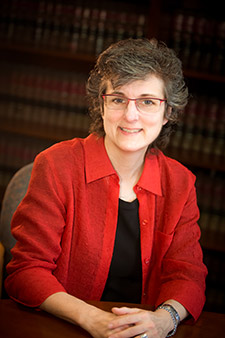1 year and 105 jury trials later, Milwaukee County courts continue efforts to return to normal
By: Rick Benedict//June 30, 2021//
1 year and 105 jury trials later, Milwaukee County courts continue efforts to return to normal
By: Rick Benedict//June 30, 2021//

It has been nearly a year of in-person, pandemic-related operations for Wisconsin’s First Judicial District, and every day still brings new questions for Chief Judge Mary Triggiano.
As she describes how Milwaukee County courts have been returning to in-person proceedings, a staff member interrupts to ask: Where should warrant return walk-ins be sent?
“There are all sorts of things that happen like that on a daily basis where we have to figure out where we’re putting people,” Triggiano said.
Milwaukee County courts resumed in-person proceedings with precautions in place on June 29 last year, following about three months of operating virtually. In July, two courtrooms opened for in-person trials and additional rooms were added in October and May.
By June 14, Milwaukee had 13 courtrooms open for in-person proceedings and 11 courtrooms open for jury trials. Judges have held 105 jury trials in total, most of them for criminal cases.
Masks and social distancing are still required in the courthouse, and hand sanitizer and Plexiglass barriers remain in place. Triggiano said she’s working with county health officials and the county’s recovery team as the court moves toward a new milestone: Getting judges in the county’s criminal division back into their courtrooms by Labor Day.
“Our next goal is really working to get the criminal division up and running pretty much on pace with pre-COVID numbers,” Triggiano said.
The Wisconsin Law Journal talked with Triggiano about what it will take to reach that goal and how the lessons of the past 12 months are influencing what’s happening now.
The Wisconsin Law Journal: What does the case backlog look like for the First Judicial District?
Triggiano: The criminal division has the highest backlog of cases. We have a family division that seems to be keeping up pretty well, and civil division is keeping up. Children’s court may have a smaller backlog, but by and large, our criminal division has the highest backlog of cases. It’ll probably take us about 18 months to two years to get through the backlog.
WLJ: How are you working through the backlog as new cases are coming in and precautions remain in place?
Triggiano: We’ve been trying to do as many cases as we can either remote or in person. Getting jury trials up and running was really important because if you have a jury trial slot, then you can stack cases, and you have potential resolution of cases when you have jury trials that are ready to go. We’ve had the ability to use some reserve judges to help with the backlog, but it’s just a matter of our judges really working hard, which they have been day and night, trying to figure out how to keep their cases going either via Zoom or in person.
WLJ: What factors go into your evaluation of the health and safety measures in place for the First Judicial District?
Triggiano: We are working with the county’s public health experts and the county recovery team to look at that as they keep monitoring the viral spread in the community, as well as the number of vaccinated people. The viral spread seems to be going down to all-time lows. The vaccination rate is not quite where we want it, and a lot of people who would come into the courthouse may not be vaccinated, and so we want to be careful about that as well. So those two things are sort of our guideposts: Has the viral spread gone down to a point of one per 100,000, and is the vaccination rate going up to where we feel comfortable alleviating some of those precautions?
WLJ: What has been your approach to reopening courts in Milwaukee County?
Triggiano: If you look at the progression of our phased, in-court reopening, it’s taken a very slow, stepwise approach knowing that we still have a virus out there that can impact the court litigants, as well as the community and stakeholders. I call it sort of our four prongs of taking a look at what we need to do to safely reopen. One is people. What are your human resources to do this? The second is the process. What is the process going to be, and how can we be efficient and effective while keeping people safe? The third is technology. What do we need to do to actually make sure we’re able to do remote hearings, as well as in-person hearings?
The last one, which is probably where we’re most struggling but we need the most, is what is the data showing us? Backlog data, community data around the spread of the virus and the vaccination rate, court event numbers, disposition rate. That’s going to make us look at the backlog in a different way.
The other set of data that we really need to take a look at is anecdotally, we believe that more people are coming to their hearings via Zoom. And then we know there’s a number of people who can’t. (So) what is the impact of video conferencing on access to justice or due process rights? The research is out on that, and so we need to really be careful about saying, we’re going to use Zoom for these certain things. I think it’s a tool that we can use, but we have to look at its impact.
WLJ: Do you feel any pressure to change your operations or speed up decisions as other courts in the state are back to pre-pandemic operations?
Triggiano: No, I don’t feel any pressure. We have had the benefit of public health expertise, county people helping us recover, our own stakeholder groups working together day in and day out, trying to be smart about how we do this. With the volume we have, I think it’s phenomenal that we were able to resume and are still doing jury trials.
One of the benefits of our slow, stepwise approach is we didn’t contribute to the spread of this virus in our courthouse community or in the community at large, and I think that was really important. We have 4,500 people who would come into the courthouse daily, including litigants and staff, between children’s court and our court. We had a huge responsibility with that number of people to keep people safe, and there’s really no other county that has the volume that we do.
I’m very proud of my judges, court commissioners, court reporters, clerks, the litigants that we’ve worked with, the county who’s helped us. The relationships really, really mattered in getting us up and running during the most prolific crisis that we’ve had in our lifetime in the courts and in the community. We did an amazing job, but it was because we had a team of people working together all the time on this.
Legal News
- State Bar leaders remain deeply divided over special purpose trust
- Former Wisconsin college chancellor fired over porn career is fighting to keep his faculty post
- Pecker says he pledged to be Trump campaign’s ‘eyes and ears’ during 2016 race
- A conservative quest to limit diversity programs gains momentum in states
- Wisconsin prison inmate pleads not guilty to killing cellmate
- Waukesha man sentenced to 30 years for Sex Trafficking
- 12-year-old shot in Milwaukee Wednesday with ‘serious injuries’
- Milwaukee man convicted of laundering proceeds of business email compromise fraud schemes
- Giuliani, Meadows among 18 indicted in Arizona fake electors case
- Some State Bar diversity participants walk away from program
- Wisconsin court issues arrest warrant ‘in error’ for Minocqua Brewing owner
- Iranian nationals charged cyber campaign targeting U.S. Companies
WLJ People
- Power 30 Personal Injury Attorneys – Russell Nicolet
- Power 30 Personal Injury Attorneys – Benjamin Nicolet
- Power 30 Personal Injury Attorneys – Dustin T. Woehl
- Power 30 Personal Injury Attorneys – Katherine Metzger
- Power 30 Personal Injury Attorneys – Joseph Ryan
- Power 30 Personal Injury Attorneys – James M. Ryan
- Power 30 Personal Injury Attorneys – Dana Wachs
- Power 30 Personal Injury Attorneys – Mark L. Thomsen
- Power 30 Personal Injury Attorneys – Matthew Lein
- Power 30 Personal Injury Attorneys – Jeffrey A. Pitman
- Power 30 Personal Injury Attorneys – William Pemberton
- Power 30 Personal Injury Attorneys – Howard S. Sicula











